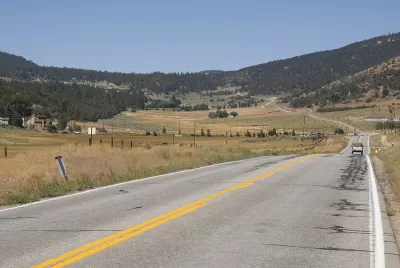Michael Hibbard at the University of Oregon and Kathryn I. Frank at the University of Florida write about their recently published article in the Journal of Planning Education and Research.

There is an urgent need to reinvent rural planning. Although more than half the global population (and 80 percent of the U.S. population) is urban, 97 percent of the landmass (both global and U.S.) is non-urban. Still, planning has a tendency to regard all space as urban and non-city-dwellers as part of the global urban population, even though rural areas produce virtually all of the planet’s food, fiber, timber, minerals, and other essential resources; supply most of the industrial and domestic water used by cities; and host the vast majority of the planet’s animal and plant species. Rural landscapes are also the locus of many pressing issues, from climate change to economic restructuring to biodiversity loss to demographic change. It is not an exaggeration to say that rural areas are essential to the planet’s future. Planning needs to engage meaningfully with rurality. As APA’s 2020 Research Agenda for the Planning Profession observed, planning "will need to overcome its urban bias, and planners will need to apply new insights, skills, and practices to help small towns and rural communities."
As one response, in an article for JPER we asked how planning can broaden its view to better attend to the rising challenges facing rural areas that are critical to society as a whole. The recent 'cultural turn' in planning scholarship provides a useful approach.
Technical definitions based on such criteria as size and density assume 'urban' as the norm and 'rural' as a residual—whatever is not urban. In this view all planning is the same: urban, regardless of where it is practiced. But the cultural turn sees planning as a cultural practice, embedded in particular social, political, and economic contexts that shape the ways planning is conceived, institutionalized, and carried out. Planners speak and act differently in Los Angeles, Zurich, and Jakarta. Similarly, urban and rural cultural context matters.
We developed a framework linking planning practice to urban and rural cultures and then conducted a content analysis of planning literature to understand the nature of urban bias in planning. Finally, we considered how planning might look through the lens of rural culture.
Planning’s urban bias comes as no surprise. Planning initially emerged to deal with the problems of rapidly growing industrial cities and continues to place a heavy emphasis on the fact that most people live in cities, including exurbia. Defining planning as urban imposes an urban meaning on the rural. In this framework, "rural" is the urban fringe, ten to forty miles adjacent to the urban center. It is latent urban space, waiting to be incorporated into the metropolis it is culturally or economically linked to. However, there is another "deep rural" space: physically, economically, and socially distant from the metropolitan region, with little prospect of merging with it.
The dominance of urban culture inflicts serious costs on deep rural places and residents, bringing us back to our question, slightly reframed: In light of the importance of rural areas for society as a whole, can planning be reimagined to use the concept of culture to better attend to the rising challenges facing them? Our inquiry found three themes that seem especially relevant for a new rural planning.
- Urban culture, and thus planning, tends to prioritize efficiency over community. Planning would better attend to the challenges facing rural areas if it recognized that rural culture prioritizes community over efficiency.
- Urban culture, and thus planning, aims to maximize output and minimize costs through the most efficient use of resources and technology. Planning would better attend to the challenges facing rural areas if it recognized that in rural culture the economy is not just a way to make a living, it is a way of life.
- Planning would better attend to the challenges facing rural areas if it recognized that both resource production and conservation primarily benefit urban people and that rural culture prioritizes working landscapes and multifunctional approaches to land use, with multiple socioeconomic and ecological benefits and urban–rural linkages.

Maui's Vacation Rental Debate Turns Ugly
Verbal attacks, misinformation campaigns and fistfights plague a high-stakes debate to convert thousands of vacation rentals into long-term housing.

Planetizen Federal Action Tracker
A weekly monitor of how Trump’s orders and actions are impacting planners and planning in America.

In Urban Planning, AI Prompting Could be the New Design Thinking
Creativity has long been key to great urban design. What if we see AI as our new creative partner?

How Trump's HUD Budget Proposal Would Harm Homelessness Response
Experts say the change to the HUD budget would make it more difficult to identify people who are homeless and connect them with services, and to prevent homelessness.

The Vast Potential of the Right-of-Way
One writer argues that the space between two building faces is the most important element of the built environment.

Florida Seniors Face Rising Homelessness Risk
High housing costs are pushing more seniors, many of them on a fixed income, into homelessness.
Urban Design for Planners 1: Software Tools
This six-course series explores essential urban design concepts using open source software and equips planners with the tools they need to participate fully in the urban design process.
Planning for Universal Design
Learn the tools for implementing Universal Design in planning regulations.
Gallatin County Department of Planning & Community Development
Heyer Gruel & Associates PA
JM Goldson LLC
City of Camden Redevelopment Agency
City of Astoria
Transportation Research & Education Center (TREC) at Portland State University
Jefferson Parish Government
Camden Redevelopment Agency
City of Claremont






























